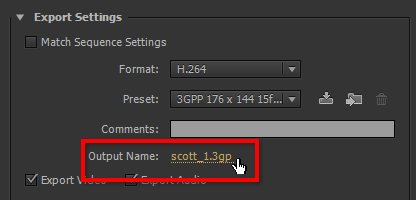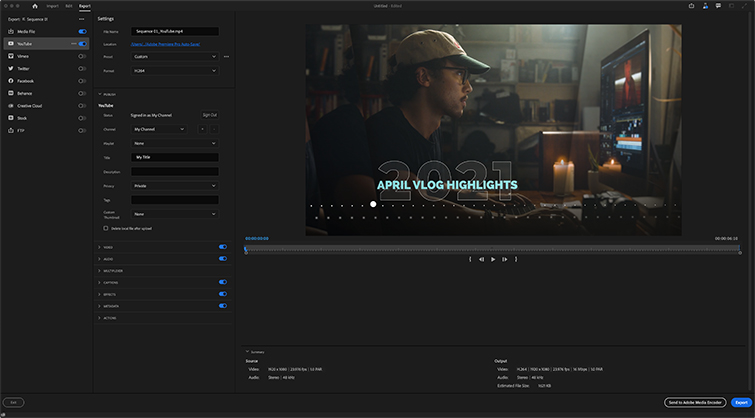

- ADOBE PREMIERE PRO EXPORT ONE CHAPTER HOW TO
- ADOBE PREMIERE PRO EXPORT ONE CHAPTER MP4
- ADOBE PREMIERE PRO EXPORT ONE CHAPTER FULL
As an example, footage shot at 50fps should be added in a 25fps sequence in order to slow the footage down by 50%. If you do want to shoot slow-motion though, you should know that it is meant to be slowed down in multiples, so the frames are rendered correctly, without jumping. Therefore we always want to work in a sequence between 23.97 and 30 fps maximum, and nothing higher. If you are shooting a gaming video though, you can use a 50fps, because your audience may be used to it. Most videos are usually shot in 24fps, which is the most pleasing framerate for the eyes. They generally work in multiples of the base project framerate.Ī common mistake is when people shoot slow motion, which usually runs at about 50-60 fps, and they create a sequence at this framerate, but this won’t bring anything good. This being said, if your camera shoots at 29.97fps, you should set your project at 29.97fps. If it doesn’t, you will experience some issues with jumpy footage. Setting the Frame rateīefore you start working on your video, you need to make sure that your footage frame rate matches your project settings. If you simply create a timeline in HD, then you won’t be able to export in 4K at all.Ĭheck this tutorial to learn the best sequence settings for Premiere Pro.
ADOBE PREMIERE PRO EXPORT ONE CHAPTER FULL
The reason is that you can export the full 4K video, and get the best out of your footage, or just export in HD as long as your timeline is set to 4K already. If, for example, you have footage of different resolutions, such as 1920×1080(HD) and 3840×2160(4K), our advice would be to use the highest resolution. This means that if you shoot in 3840×2160, the timeline needs to match it perfectly. The first thing you want to do is make sure that your sequence matches your camera resolution. Look here to find the best sequence settings to use for YouTube. After you import everything in Premiere Pro, you will need to start working on your video!

The first thing we need to look into is the creation of your timeline.
ADOBE PREMIERE PRO EXPORT ONE CHAPTER HOW TO
Check out that blog post for a more in-depth explanation of how this works.ĮDIT: Changed the code, as the original would not allow spaces in file names.Summary How to create a new Sequence/Timeline

Myfile.write(text) Credit to iKyle at his blog for his original script, which I modified to work specifically with the way Premiere exports markers. With open("FFMETADATAFILE", "a") as myfile: Specifically, the python script needs to be named prpro_ffmpeg_chap.py or the batch script won't work.ĭrop Video Files Here To Add Chapters.bat Haven't tested, so I don't know.Ĭopy/paste these scripts into new files along with the file names I specified.
ADOBE PREMIERE PRO EXPORT ONE CHAPTER MP4
mp4 files, but may also work with other containers like. This will iterate through all of them, and make new files called something like Video1-chapters.mp4 Note that if you uncomment the last two lines of the batch script (removing "REM"), it will replace the original file instead of creating a new one. Once those things are installed and everything's in the same folder, just drag/drop all the video files onto the. If you haven't already registered FFmpeg on the command line globally and don't want to bother figuring that out, simply put FFmpeg.exe in the same folder as your video and text files. Now, onto the script itself, which requires Python3 and FFmpeg to be installed.

txt file is the same name as your video file (e.g., Video1.mp4, Video1.txt) Then go to File > Export > Markers, and choose Text File (.txt), and the same output destination as where your video file is. Next, right click the time code, and chose "milliseconds" instead of "audio samples" Second step is to go to your sequence and select "Show Audio Time Units" inside your sequence's hamburger menu within the timeline panel. If your markers don't have descriptions, they will simply be named "Chapter 1, Chapter 2, etc." in the end result I don't know why this is, but Premiere only exports descriptions, not the titles. "Start of Concert"), you need to put the chapter names in the "description" area of the marker, not the title. If you want your marker names to be visible in VLC as chapter names when you play the file back (e.g. Note that this only works with sequence markers (ones made on a timeline while no clips were selected), not markers on individual clips. Scripts are at the bottom of this post, here's the steps for how to make it happen:įirst is to properly set up your markers. This will only work on windows, but if you know a bit of coding, a macOS version shouldn't be too hard to figure out. However, I came up with a workaround using FFMPEG, Python, and a batch script. So, I had a project that necessitated this, and found it wasn't directly possible.


 0 kommentar(er)
0 kommentar(er)
